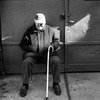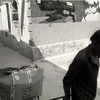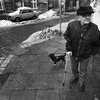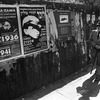Reclaiming the Past: The Galicia Museum
A new museum opened in Cracow's historic Jewish district a fortnight ago under the name of the Galicia Jewish Museum. Coupled with the recently re-opened Wyspianski, it offers an inspiring sign that modernity is being embraced in the weird and wonderful world of Cracow's museums, and that when money can be found, great things can be achieved. Cracow has some marvellous museums, but a good deal feel stuck in the fifties - several of the exhibits at Auschwitz itself are literally peeling away, and would benefit enormously from a rethink.
The Galicia Museum itself is modest in size, but the modern use of light, the fine structural arrangement and the elegant yet restrained handling of the interior, lend it a style that would not be out of place in swanky Western cities such as London or New York.
The Museum plans to host exhibitions, workshops and conferences on Poland's Jewish Heritage, and an excellent bookshop and cafe are on hand (both woven into the open plan design of the museum) making this a fine place to drop by, where you could comfortably settle in for a good few hours or so.
The Museum has kicked off its programme with a stunning exhibition of photographs by director Chris Schwarz about the lost Jewish world of Polish Galicia. Galicia was the name that was given to Austria's lands that lay to the north of the Carpathian mountain range. The majority of this territory was stolen from the Poles in the late eighteenth century, when Poland was itself erased from the map. With Poland's resurrection after the first world war, about two thirds of the region were incorporated into the new Poland, whilst a great chunk was removed by Poland's Allies following World War II, when her borders were rolled west to Breslau and beyond.
Although a region of often enchanting beauty, both in its landscapes and in many of the towns and cities, Galicia was also a backward region, often gripped by poverty in its backwaters - hence the vast waves of immigration during the late nineteenth century. Nevertheless, there exists a certain nostalgia for this world - the Austrians took a liberal course during the late nineteenth century, a move that was not followed in Russian or Prussian Poland, and Galicia became the font of Polish culture during the years leading up to the first world war.
One of the first images in this powerful exhibition is a list of Galician cities, towns and villages that possessed one hundred or more Jewish inhabitants before the war. A mere glance at these lists gives an immediate sense of just how large a world was lost during the war. Several hundred places are listed, ranging from the great cities (Lwow: 76,854 Jews) to provincial towns (Drohobycz 11,854) to the numerous smaller towns and villages that housed long-established Jewish communities.
The first part of Chris Schwarz's exhibition looks at some of the traces of this world. And if some of these images appeared in a dream, one might feel that one had entered an enchanted world. Trees curl out of crumbing eighteenth century ruins and pagan looking stones emerge from grassy knolls. In another image, more remnants of these stones appear, now swathed in ivy on the floor of a dense forest. Yet these are not the relics of some ancient civilization, rather, they are the abandoned synagogues and graveyards of a world that was still functioning sixty five years ago.
Whole towns and cities were crumbling away in Poland during the inertia of the Communist years. A great deal of heritage was simply lost. A dozen or so palaces of the nobility were turned into museums, as were a handful of synagogues. But so much of Poland's heritage, both Jewish and Polish, was left to rot.
Polish Jewish relations are a complex and highly sensitive issue. The Polish government itself propagated anti-semitic propaganda during the late 60's (partly to shake up the power arrangement within the party), claiming that Jews (only several thousand remained) were supporting Zionist aggression in the Middle East.
On the one hand, Poles saved more Jews than any other nation did during the war, even though the Germans enforced decidedly stricter punishments (whole families would be executed) on those that attempted to help Jews. However, there are ghosts in the cupboard, and the process of self-analysis that occurred after the war in Western countries was delayed in Poland, where the Soviet backed government saw to it that a highly unbalanced picture of the war was promoted. With the return of freedom of speech, the era is being explored afresh, and the Galicia Museum is well-placed to be a part of this.
The second part of Schwarz's exhibition stands in stark contrast to the first. Here we see a handful of relics that have survived the last fifty years in a reasonable state. Ornate, often grandiose synagogues offer a vibrant echo of the world that was. Jews had settled in Poland since the medieval era, often fleeing from pogroms in Western Europe. The tolerant mindset of Poland's Renaissance elite gave rise to the emergence of large Jewish communities who developed sophisticated cultures - Cracow's Kazimierz (once a town in its own right) was famous throughout the Jewish world as a centre of academic brilliance.
The third part of the exhibition highlights the way in which the Jewish world was snuffed out. The Galician town of Oswiecim is known throughout the world by the name that the Nazis gave it in 1939, Auschwitz. Schwartz's arresting photographs of snow-swept camp interiors, stark wooden sleeping quarters and the apparatus of the murders themselves (the ruins of the gas chambers survive), bring home the clinical manner in which the Final Solution was achieved, as well as the excruciation of camp life for those who were at the mercy of the elements.
Equally thought-provoking are the images of lesser known sites of murder. Isolated monuments (often no more than plaques) are to be found dotted across the Polish countryside. It was common practice for the Nazis to round up the Jews of a given town or village, and then shoot them en masse.
Images of surviving pieces of Cracow's wartime ghetto wall, and the dilipidated villa of Camp Commander Amon Goeth, remind us how little time ago all this happened.
By highlighting some historic sites that have been neglected or those that have found themselves robbed of dignity (be they vanishing Jewish graveyards or the surreal case of the synagogue in Kalwaria Zebrzydowska which is now a furniture store) the exhibition lights a flare over the still relatively poor land of Galicia. For in contrast to the scenes of neglect there are also images of successful works of remembrance: gardens, museums and other monuments, some built by Poles, others by the Jewish diaspora. Potentially, there is vast amount of work lying in wait for conservators.
The exhibition ends on an optimistic note, drawing attention to those institutions and people, young and old, who are involved in the process of remembrance here in Poland, and the message of tolerance that is inextricable from this.
Ultimately, this exhibition is not only a masterful record of a vanished world (in Cracow alone there are no more than 500 Jews today, as opposed to 45,000 before the war) but also a deeply thought-provoking exploration of the Holocaust and its legacy. British-born photographer Chris Schwarz has devoted many years of his life to compiling these images, and they form an incomparable record that is both haunting, shocking and yet also stunningly beautiful. Certainly, the lack of images from the Ukraine (over half of Galicia lies in today's Ukraine) is a great shame, but the quality of the images that have been recorded thus far are examples of the 'quality not quantity' ethos. However, now that Schwarz is based here more permanently on account of his post as director of the Museum, he is well placed to make forays across the border, and we can only hope that he will turn his attentions to this orbit and complete the astonishing picture that he has started! Yet all in all this is a magnificent exhibition, and the Galicia Museum promises to be a inspiring, and hopefully permanent fixture in Cracow's cultural life.
Galicja Muzeum: ul. Dajwor 18, Krakow
http://www.galicjamuzeum.org/

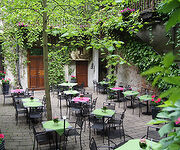 Kawaleria Szarza Smaku
Kawaleria Szarza Smaku
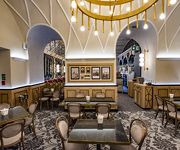 Europejska
Europejska
 Krakow Pinball Museum
Krakow Pinball Museum



